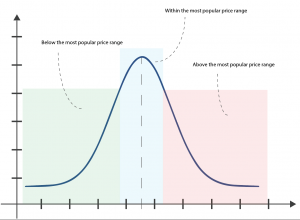For merchants selling physical products, advertising on Google Shopping is indispensable and is part of the mandatory program. Google Shopping ads have above average conversion rates and the reason for this is as obvious as it is ingenious: The customer receives all important and relevant product information at one go! Product image, price, shipping, provider and so on.
Part of the success of Google Shopping is simply due to the fact that it is comparatively easy to get started. So it is quite possible to set up the advertising rudimentary at first, set a general low click bid and then just let the campaign run. Because Google automatically shows the products when the search queries match, there is no need for a complex campaign setup.
Although such a cautious approach certainly does not lead to optimal results, it can generate turnover even on a low flame. For a fully-fledged Google shopping strategy, on the other hand, more work should be invested in product data as well as in setting up and controlling the campaigns.
With the classic Google Shopping ads you have the greatest control over the delivery and all campaign settings like conversions, or maximizing clicks. In addition, the click bids can be set manually and the priority of the campaign can be set if you have multiple shopping campaigns promoting the same product. Within classic shopping campaigns, individual product groups can be segmented, e.g. by brand, so that different bids can then be placed for the individual product groups. In structuring, however, merchants are not bound to assigned attributes. A retailer can also use several user-defined labels. Structuring according to such information can bring great advantages, as bestsellers or products with high margins can justify higher bids. However, the prerequisite is that the corresponding data is maintained, which can take a lot of time.
In addition to the normal Google Shopping campaigns, Google has rolled out the Google Smart Shopping campaigns in 2018. The aim is to move further and further in the direction of automation and thus save retailers a lot of time and effort. Smart Shopping campaigns use machine learning to automate bidding at auctions and to display ads for product listings on Google. This makes it a good option for newer advertisers or those who do not have the resources to manage standard shopping campaigns. Smart Shopping is extremely easy to set up and includes a number of different ad types. Especially for merchants who want to start advertising on Google very quickly or cannot/do not want to spend enough time on campaign setup, it is an ideal option. However, Smart Shopping campaigns can only be used if conversion data is already available within the last 30 days. Smart Shopping campaigns combine existing product feeds and assets with Google’s machine learning to deliver a variety of ads across multiple networks.
But what means support for one person means control-loss for another person. This is the most important trade-off that merchants must consider when they decide to use smart shopping ads: Control against time.
While the ease of set-up can be a big advantage, it can also be a disadvantage, as Smart Shopping offers little opportunity for customisation. Only the target ROAS alone can be adjusted, further settings are almost non-existent. Also the structuring of the campaigns is not very diverse, because only a division on the highest level, e.g. the categories, is possible. It is recommended to combine as many products as possible in one campaign due to the amount of data, but this is strongly disadvantageous for retailers with a diverse assortment and different margins and target ROI.
But according to this, retailers would have to choose between higher control, but more investment time and less control and less investment time. This could be unsatisfactory for many traders, because control and time should at best also change in the opposite direction, i.e. more control and less time. This is exactly where emarketing comes in. Even with emarketing, Google’s black-box-behaviour cannot be made more transparent, but the app allows more control for more granular segmentation and optimization.
emarketing offers so-called product groups, on the basis of which campaigns can run on Google Shopping as well as Facebook/Instagram.

emarketings default product groups
Product groups of emarketing consist either of manually selected products, selected product categories or smart filters. The manual filter allows you to select product manually from your product list, the category filter allows you to select products based on your webshop categories and the smart filter provide you dynamic product selection. The product groups provide a wide range of segmentation possibilities, emarketing has created default product groups that can also be used for campaigns.
For example, emarketing sets a Best Price product group:
This product group is based on a smart filter, which summarizes all best-price products, i.e. all products that have the lowest price compared to the competition. The best price filter allows retailers to promote only competitive products, so that the marketing budget is not burned unnecessarily. But what makes this filter so smart anyway? The filter offers customers further options for more specific settings.
For example, certain products can be manually excluded despite the best price. In addition, a filter tolerance can be set so the filter still remains products that are up to x % more expensive than the cheapest offer.
New products:
Quite simple, all recently added products go here. Maybe you want to set a different daily budget for new products than for older ones.
Products priced “very attractive”, products priced “at fair price” and products priced “too expensive”:

Below, between and above the most popular price range
This product group contains the filter Mostly used price. This filter has three different comparison settings: Below the most popular price range, Within the most popular price range and Above the most popular price range. The Product group “Products priced very attractive” uses the Below setting, the product group “Products priced at fair price” uses the Within setting and the product group “Products priced too expensive” uses the Above setting.
The different filters do not have to be used individually, a combination of several filters is also possible. This way, a filter set can be created which only advertises converted products with best price.
In contrast to Google’s holistic approach, emarketing does not rely on reduction but on segmentation and transparency. Thus, users are guaranteed to have full control over their marketing budget and still have the capacity for strategic work. The high manual effort involved in creating and managing campaigns is eliminated and in-depth analysis and optimization can be worked out. Thanks to the Smart Filter, emarketing combines time reduction with decision-making and influence.
You can create multiple product groups for use with different campaigns / platforms.
Smart Filter: Products will be selected automatically based on performance data from Google Ads or product data from Google Merchant Center. Smart Filters are dynamic. When performance / product data changes, your product selection will be adjusted based on the changes.










